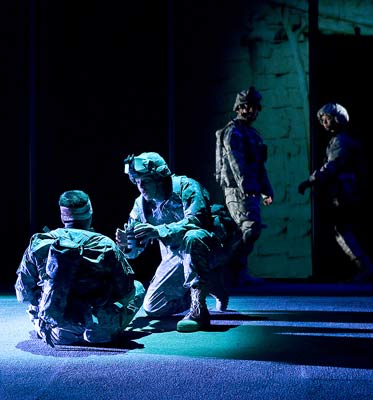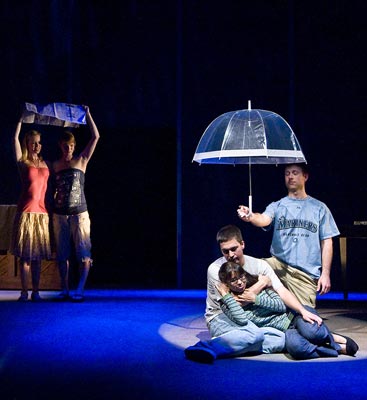Plumfield, Iraq
At UCSB, Sunday, May 18.

Barbara Lebow’s new tour de force play Plumfield, Iraq moved the audience, regardless of their political stance. Although the title refers to two specific locations, the dramatic text of this world premiere questions any war, at any time. The UCSB production, directed by Risa Brainin, incorporates contrasting images of the real and imaginary to depict war’s traumatic effects on soldiers’ psyches.
When the two Plumfield high school seniors, Cam (Brennan Kelleher) and Mike (Charlie Faith), enlist in the military, it’s to escape the rut of their parents’ lives. It’s 2003, and they trust the public announcement that the war in Iraq is over. The prospect of a free college education and the pursuit of their dreams unites these childhood friends. In his naivete, Cam likens the glory of the “mission accomplished” to the movie Top Gun. Imbued with youthful energy and physicality, the early scenes in Act I are like snapshots of innocence: falling in love, playing football, and dancing on prom night. Brennan Kelleher is thoroughly convincing in his portrayal of Cam’s misguided optimism.

If Cam’s charismatic presence dominates the first act, it is Mike’s tortured mind that darkens the second. With remarkable fluidity, the flashbacks and brief vignettes that accompany Mike’s interior monologues are joined to jarring, ominous sounds. A musician who is by nature quieter than Cam, Mike suffers from post-traumatic stress disorder. The use of multimedia to present Cam’s wife, Lorraine, and her effort to keep the memories of her marriage alive is particularly effective. But Mike’s shattered innocence makes him an unlikely communicator. It is atonement he seeks, and he seeks it in vain.
The ironic juxtaposition of certain images, such as the crashing explosions of weapons and 4th of July fireworks, heightens an otherwise predictable plot. Furthermore, the joy in the troops’ singing and Mike’s piano playing, or the tenderness in the Japanese mythical storytelling, all contribute to the expression of strange beauty amidst pain. The human shadows on the wall appear as delicate as the paper crane that his partner Beth gives to Mike to remind him of peace.
The lighting design by Michael Klaers fittingly interprets this theme, and Tal Sanders has envisioned an equally appropriate set to reflect the play’s duality. Perhaps the play’s historical events are too recent for an objective perspective, but in any case, the loss of innocence, played so truthfully by the young actors, is not necessarily only true of the war in Iraq.



